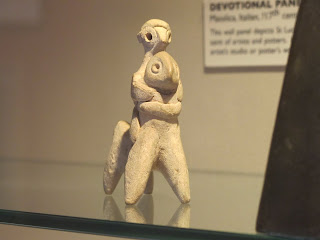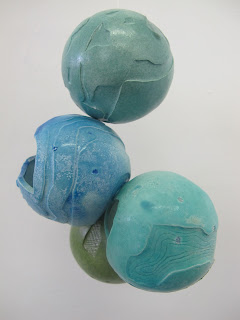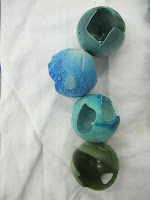I decided to work with porcelain as my clay body to help achieve the girly, lacy, delicate quality within the pieces. This was my first experience of porcelain and due to this I encountered many problems and issues over the past few days.
Beginning with the plate, I worked with thinly rolled out sheets of porcelain onto which I rolled my lace pattern and then carved into. My first attempt was carved on the flat plaster slab on which I had rolled the clay, however when I lifted the carved and thus weakened sheet in order to place it over a hump mould to shape it, it fell apart due to the change in shape. Due to the thinness of the clay, it also dried much quicker than I was able to work, causing cracks. In my next attempt, rolling the clay a little thicker, I first laid it over the hump and then carved it. This was much more successful and I managed to attach feet and take it off the mould the next day with only minor cracks. The feet were too big though and not in keeping with the design. Also they needed to be placed further out, closer to the edges.
My first attempt.
The next plate unfortunately cracked and fell apart while I was cleaning up its edges but I was able to salvage sections which make quite cute little plates in themselves. Plate number three was happily the most successful.
Not being experienced with the potential softness of porcelain during firing, I didn't use any support for my first plate in the kiln and consequently the edges flopped miserably and so my shape was completely lost. The third plate I coated with a dusting of talc and is in the kiln now in a bed of malachite so I'm hoping for a slightly more shiny finish and that its shape has been preserved!
These are some early cup designs made using a slab around a plaster mould for the first one, slip trailed porcelain slip inside a mould for the second one. The bottom two are slip cast over slip trailed designs inside the mould in pink and white.
I liked the first design best so attempted another one with a much more fitting handle which all fell apart as it was drying. A third successful attempt is pictured below in its green state. This is to be fired to 1220 today so I'm hoping with a support as with the plate, it will survive the heat intact.
My implement is a very simple suggestion of a spoon. Two designs are photographed below. These were in their very early stage, previous to their edges being tidied up.





















































